Belarus Tour Guide: Ideas for Your Trip!
What to see in Polotsk: Majestic St Sophia, the treasures of St Euphrosyne, the book printing legacy of Francysk Skaryna and other sights of the oldest town of Belarus
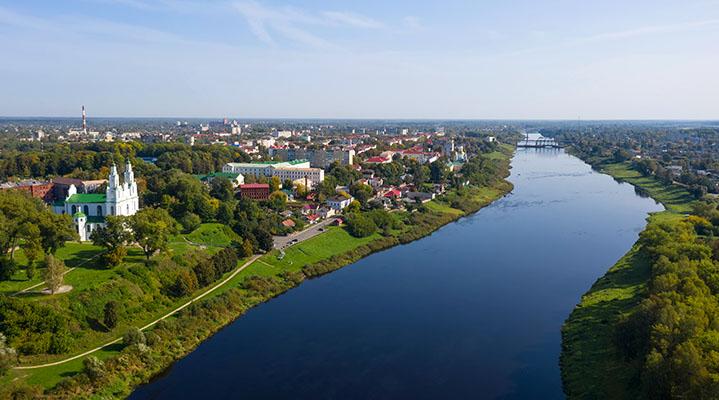
Polotsk is worth visiting to feel the atmosphere of one of the first major towns of the Eastern Slavs, to stroll down the streets that keep secrets of centuries-old history, to see the legendary temples and listen to the organ of the famous St Sophia Cathedral… Polotsk has been included in the list of the main cultural, religious and tourist routes of the country. Here cathedrals and monasteries stand next to rare monuments and unusual museums. The town hosts The Bells of St Sophia festival that has become its calling card attracting the most sophisticated music lovers.
The first mention of Polotsk dates back to 862. The Tale of Bygone Years refers to the town on the Polota River at its confluence with the Western Dvina as Polotesk or Polot’sk. It rose at the crossroads of important trade routes and was part of the famous artery ‘from the Varangians to the Greeks’. The place grew rapidly to become the Principality of Polotsk, once part of Kievan Rus, in the 10th century. It remained a major cultural and economic center for more than three centuries.
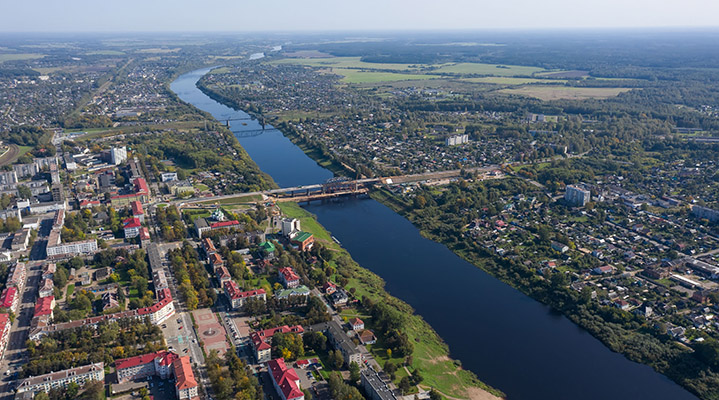 Throughout its history the Principality of Polotsk was ruled by the famous Prince Rogvolod, who hailed, according to some sources, from Scandinavian lands, Izyaslav, the forebear of the Polotsk dynasty Izyaslavichis, Bryachislav, Vseslav the Sorcerer, Andrei of Polotsk…
Throughout its history the Principality of Polotsk was ruled by the famous Prince Rogvolod, who hailed, according to some sources, from Scandinavian lands, Izyaslav, the forebear of the Polotsk dynasty Izyaslavichis, Bryachislav, Vseslav the Sorcerer, Andrei of Polotsk…
In different periods Polotsk was part of the Grand Duchy of Lithuania (13th-16th centuries), and later Polish–Lithuanian Commonwealth, received the Magdeburg rights in 1498. During the Partitions of Poland, some Polotsk lands became part of the Russian Empire: in 1772 those on the right bank of the Western Dvina, and in 1793 – on the left bank. After 12 December 1796 it was a provincial town of the Belarusian province, later Vitebsk province. In 1924 it made part of the Byelorussian Soviet Socialist Republic…
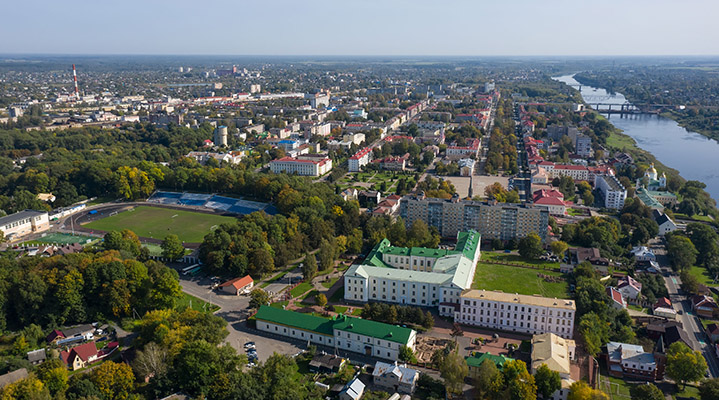 Polotsk was the birthplace of outstanding people, true legends in the history of the country. Among them is the heavenly guardian of Belarus, educator Euphrosyne of Polotsk; scholar, philosopher, East Slavic first book printer Francysk Skaryna; writer and theologian, one of Peter the Great's tutors Symeon of Polotsk…
Polotsk was the birthplace of outstanding people, true legends in the history of the country. Among them is the heavenly guardian of Belarus, educator Euphrosyne of Polotsk; scholar, philosopher, East Slavic first book printer Francysk Skaryna; writer and theologian, one of Peter the Great's tutors Symeon of Polotsk…
Being the country’s oldest town, the cradle of its statehood, culture and education, Polotsk enjoys a special status in modern Belarus. The National Polotsk Historical and Cultural Museum-Reserve was set up to protect, study and restore the monuments located on this unique historical territory. Today there are 11 museums in the reserve. All in all, about 150 historical values have been preserved in the town.
St Sophia Cathedral
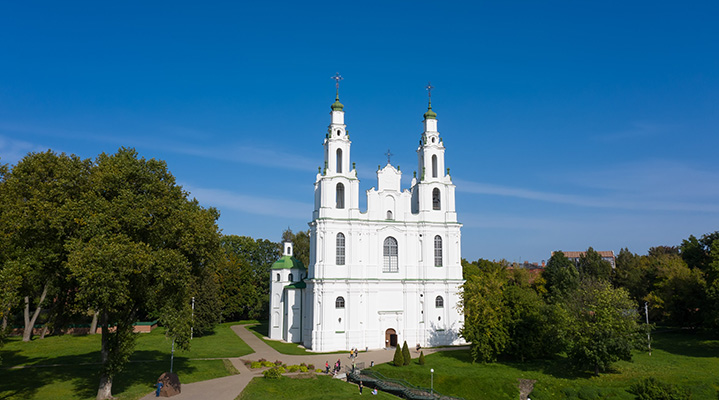 Polotsk owes its existence to two rivers - the Western Dvina and the Polota. Many religious buildings were built along the banks of these rivers. The main one is St Sophia Cathedral (1030-1060), one of the oldest in ancient Rus.
Polotsk owes its existence to two rivers - the Western Dvina and the Polota. Many religious buildings were built along the banks of these rivers. The main one is St Sophia Cathedral (1030-1060), one of the oldest in ancient Rus.
Polotsk Sophia was modeled on its ‘elder sisters’ in Kyiv and Novgorod, which, in turn, were inspired by the famous Hagia Sophia Cathedral in Constantinople. Thus it became the world’s fourth St Sophia church. However, centuries on the cathedral is a far cry of the original grandiose cross-dome structure with seven domes - in honor of the Ecumenical Councils. In the 18th century it was rebuilt by architect Jan Glaubitz into a single-apse basilica with symmetrical bell towers that reflect on the river.
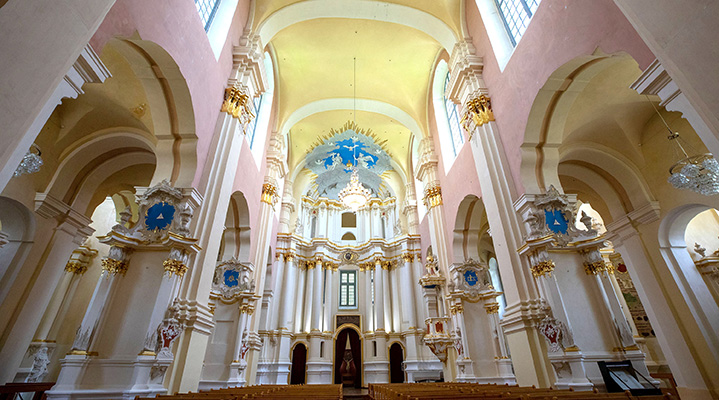 It has undergone a lot of restoration and conservation efforts throughout its history, the last one was in 1969-1983. Today the church hosts a museum and, thanks to the magnificent acoustics, a concert hall for chamber and organ music.
It has undergone a lot of restoration and conservation efforts throughout its history, the last one was in 1969-1983. Today the church hosts a museum and, thanks to the magnificent acoustics, a concert hall for chamber and organ music.
Today St Sophia Cathedral is one of the largest cultural centers in Belarus. It holds services and ceremonies, tours, concerts and soirées, a music festival called as The Bells of St Sophia.
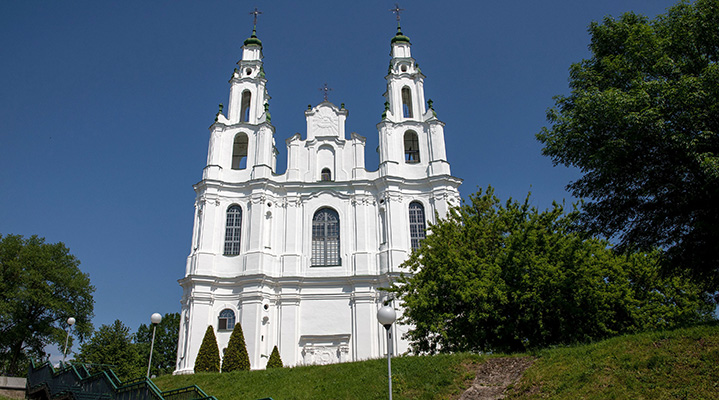 Nearby there is a huge boulder called Borisov Stone: locals believe that if you think about it with kindness, touch it, make a wish and go around three times – your wish will come true. Nearby flows a stream, the water of which is considered to have healing powers.
Nearby there is a huge boulder called Borisov Stone: locals believe that if you think about it with kindness, touch it, make a wish and go around three times – your wish will come true. Nearby flows a stream, the water of which is considered to have healing powers.
Savior and St Euphrosyne Convent
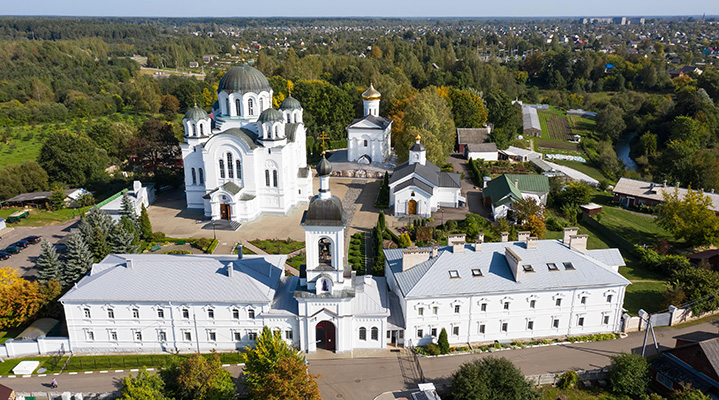 Another gem of Polotsk is the Savior and St Euphrosyne Convent which was founded by Reverend Euphrosyne in 1125. The granddaughter of Prince Vseslav the Sorcerer, Princess Predslava took monastic vows and became a nun at the age of 12. She was an educator and a philanthropist, a copyist and probably a translator of books, Mother Superior, a pilgrim. She is the first woman of Belarus regarded as a saint and revered as a heavenly guardian of Belarus. Thanks to her, two abodes were set up in Polotsk. Unfortunately, the Virgin Monastery has not survived to this day.
Another gem of Polotsk is the Savior and St Euphrosyne Convent which was founded by Reverend Euphrosyne in 1125. The granddaughter of Prince Vseslav the Sorcerer, Princess Predslava took monastic vows and became a nun at the age of 12. She was an educator and a philanthropist, a copyist and probably a translator of books, Mother Superior, a pilgrim. She is the first woman of Belarus regarded as a saint and revered as a heavenly guardian of Belarus. Thanks to her, two abodes were set up in Polotsk. Unfortunately, the Virgin Monastery has not survived to this day.
The Savior and St Euphrosyne Convent was one of the first convents in Belarus and the most important center of Eastern Orthodox Christianity. The Savior Transfiguration Cathedral is the oldest church of the convent. It was built in the 12th century during the times of the Principality of Polotsk. It is the only architectural specimen of that time that has survived in entirety to this very day. Chronicles suggest that its construction was completed in 1133 in an astonishing time of just 30 weeks. When the construction workers ran out of materials, they prayed to Euphrosyne, and in the following morning they found a new plinth in the furnace, which enabled them to complete the construction on the same day and raise the cross …
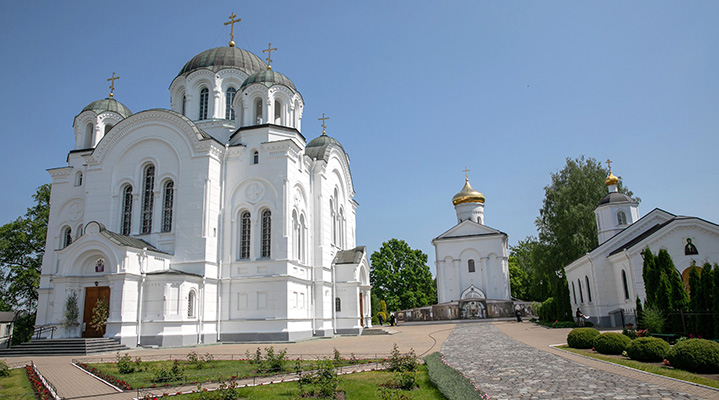 The church was built by famous architect John. A three-nave cross-in-square temple of golden-beige color sprang up on the bank of the Polota. The church was distinguished by its unusual construction solutions. For example, during excavations that have been underway here since 2015, the remains of a room were found at the depth of about 3m where the father of Euphrosyne of Polotsk was presumably buried. There were no other dungeons like that in the Ancient Russian architecture of the 10th-13th centuries in Eastern Europe. This suggests that the design of the church was custom-made by the order of the saint.
The church was built by famous architect John. A three-nave cross-in-square temple of golden-beige color sprang up on the bank of the Polota. The church was distinguished by its unusual construction solutions. For example, during excavations that have been underway here since 2015, the remains of a room were found at the depth of about 3m where the father of Euphrosyne of Polotsk was presumably buried. There were no other dungeons like that in the Ancient Russian architecture of the 10th-13th centuries in Eastern Europe. This suggests that the design of the church was custom-made by the order of the saint.
Another thing that makes this church so unique is that it is Belarus’ only 12th-century temple where fresco painting has been almost completely preserved. In the second half of the 19th century, oil painting appeared on it, but since 1992 restorers have been uncovering the most ancient images and returning the temple to its authentic look.
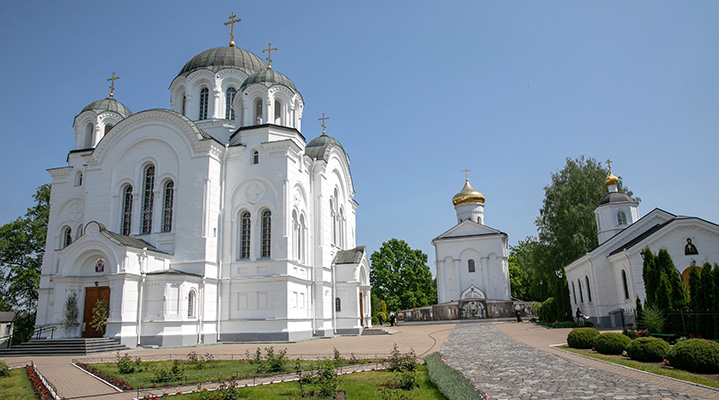 The name of Euphrosyne of Polotsk is also associated with a masterpiece of Old Belarusian jewelry art - a communion cross that was created by a local master Lazar Bogsha at St Euphrosyne’s behest in 1161. The miniatures that adorned the relic were on a par with the best specimens of Byzantine applied art. Unfortunately, the relic was lost during the Great Patriotic War, and its whereabouts are still unknown. However, in the 1990s, Belarusian jeweler Nikolai Kuzmich recreated the national asset in great detail. This re-created cross is now kept in the church of the convent. The jeweler also made a silver reliquary for the imperishable remains of the saint that have been kept in Polotsk since 1910 after being transferred from the Holy Dormition Kiev-Caves (‘Kiev-Pechersk’) Lavra.
The name of Euphrosyne of Polotsk is also associated with a masterpiece of Old Belarusian jewelry art - a communion cross that was created by a local master Lazar Bogsha at St Euphrosyne’s behest in 1161. The miniatures that adorned the relic were on a par with the best specimens of Byzantine applied art. Unfortunately, the relic was lost during the Great Patriotic War, and its whereabouts are still unknown. However, in the 1990s, Belarusian jeweler Nikolai Kuzmich recreated the national asset in great detail. This re-created cross is now kept in the church of the convent. The jeweler also made a silver reliquary for the imperishable remains of the saint that have been kept in Polotsk since 1910 after being transferred from the Holy Dormition Kiev-Caves (‘Kiev-Pechersk’) Lavra.
The beautiful architectural ensemble of the convent impresses pilgrims and tourists. In addition to the Savior Transfiguration Cathedral, it includes the Church of the Exaltation of the Holy Cross (1893-1897), the Refectory Church of St Euphrosyne, a two-story residential building, a gate with a bell tower and sororal buildings, a foundation of the vault that stood here in the 12th-17th centuries.
In the run-up to the 1,000th anniversary of the Christianizatin of Polotsk, one of its streets were named after Euphrosyne of Polotsk. In 2000 a bronze monument to the patron saint was unveiled in the center of the town.
Jesuit Collegium
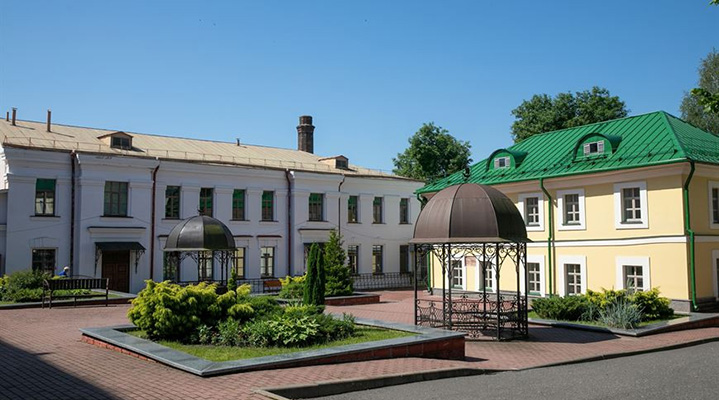 The Jesuit College was founded by King Stephen Bathory in 1580. Preacher Piotr Skarga became its first rector. The main building of the college was built at the same time. A huge fire of the 18th century burned it to the ground, but soon a new three-storey building was erected in its place along with the wooden St Stephen’s Cathedral. Later, a library and a printing house were built here.
The Jesuit College was founded by King Stephen Bathory in 1580. Preacher Piotr Skarga became its first rector. The main building of the college was built at the same time. A huge fire of the 18th century burned it to the ground, but soon a new three-storey building was erected in its place along with the wooden St Stephen’s Cathedral. Later, a library and a printing house were built here.
It is known that Stephen Bathory invited teachers from all over Europe to Polotsk. Among them was Gabriel Gruber, an outstanding mathematician and mechanical engineer who made a huge contribution to science, education and culture, and created a unique ‘mechanical head’ of a wise old man. The device could answer various questions in several languages at once. The modern version with the image of Socrates is now kept at Polotsk State University, which owns the building of the former collegium. You can talk with the all-knowing ‘Gruber's head’ in 5 languages.
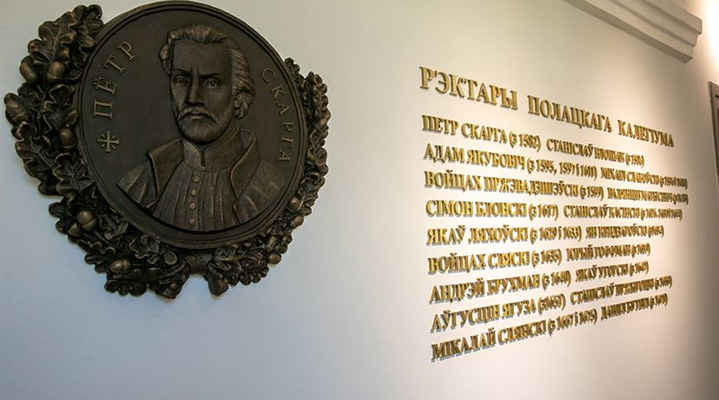 It is noteworthy that upon the order of Tsar Alexander I of Russia the collegium was re-organized and came to be known as Polotsk Jesuit Academy, which became the first higher learning institution on the territory of modern-day Belarus.
It is noteworthy that upon the order of Tsar Alexander I of Russia the collegium was re-organized and came to be known as Polotsk Jesuit Academy, which became the first higher learning institution on the territory of modern-day Belarus.
The famous architectural specimen serves its purpose to this very day. The interesting sites of the university include a monument to a student and a university clock. Every hour figures of outstanding personalities of Polotsk appear from niches under the dial in the courtyard of the old collegium to the sounds of Gaudeamus and the university’s anthem.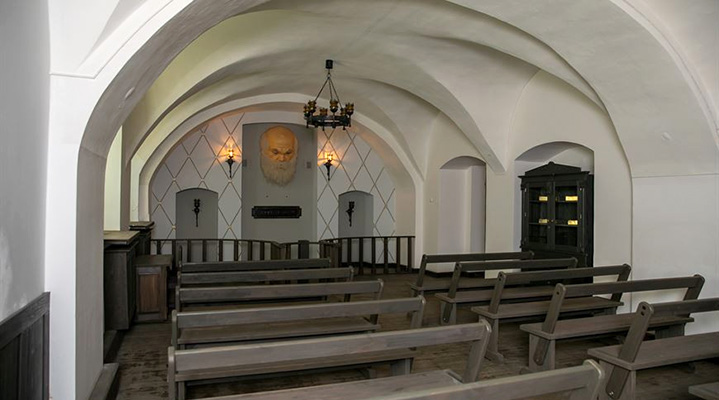
Nizhne-Pokrovskaya Street
After visiting St Sophia Cathedral you can go down the stairs to reach Nizhne-Pokrovskaya Street, the oldest and most cozy street in Polotsk, which runs along the banks of the Western Dvina River. The street is lined with two-storey houses and other buildings of the 17th - early 20th centuries. Many of them house museum expositions now. For example, the Local Lore Museum is located on 11 Nizhne-Pokrovskaya Street. This building used to be a Lutheran church in the 19th-20th centuries.
Holy Epiphany Monastery
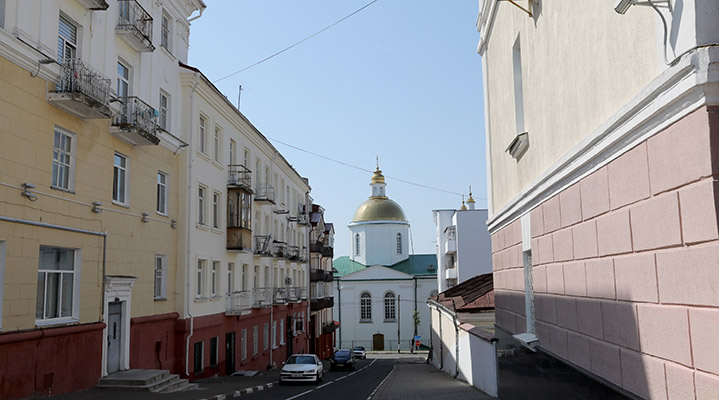 Nizhne-Pokrovskaya Street is home to the building of the former Holy Epiphany Monastery. It was founded on the right bank of the Western Dvina River in 1582 and for a long time was an important center of Orthodoxy in the town. The monastery included a brotherhood school, where Symeon of Polotsk took monastic vows. In the 18th century the stone Epiphany Cathedral was built at the monastery grounds to the design of architect Giacomo Quarenghi. The wooden brotherhood school was replaced with a solid two-storey building with monks’ cells. Later on there was a public school and a poorhouse here. During the Soviet times the monastery was turned into a residential building. Today, following a makeover, the former monks’ cells house the Museum-Library of Symeon of Polotsk and the Museum of Belarusian Book Printing.
Nizhne-Pokrovskaya Street is home to the building of the former Holy Epiphany Monastery. It was founded on the right bank of the Western Dvina River in 1582 and for a long time was an important center of Orthodoxy in the town. The monastery included a brotherhood school, where Symeon of Polotsk took monastic vows. In the 18th century the stone Epiphany Cathedral was built at the monastery grounds to the design of architect Giacomo Quarenghi. The wooden brotherhood school was replaced with a solid two-storey building with monks’ cells. Later on there was a public school and a poorhouse here. During the Soviet times the monastery was turned into a residential building. Today, following a makeover, the former monks’ cells house the Museum-Library of Symeon of Polotsk and the Museum of Belarusian Book Printing.
The Epiphany Cathedral, which housed an art gallery after its restoration in 1981, was returned to the parish in 1991. Today it is a cathedral of the Eparchy of Polotsk and Glubokoye.
Museum of Belarusian Book Printing
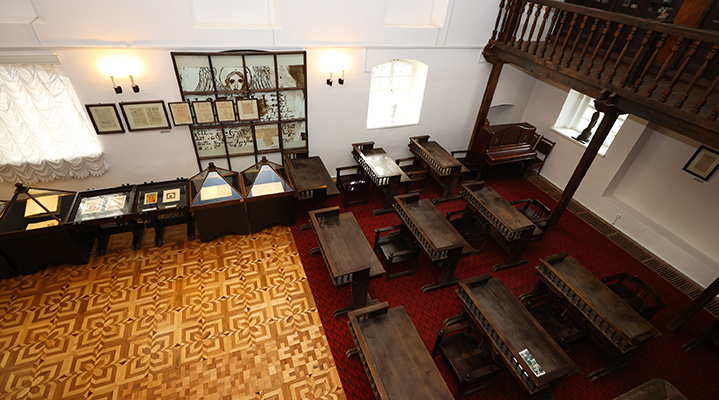 The Museum of Belarusian Book Printing, founded in the hometown of the outstanding genius of the Renaissance, is worth telling. It was Francysk Skaryna from Polotsk (1490-1551) who became the first to bring the printed word not only to the Belarusian but also to the East Slavic lands.
The Museum of Belarusian Book Printing, founded in the hometown of the outstanding genius of the Renaissance, is worth telling. It was Francysk Skaryna from Polotsk (1490-1551) who became the first to bring the printed word not only to the Belarusian but also to the East Slavic lands.
Francysk Skaryna published the The Psalter, the Bible in Old Belarusian, in Prague on 6 August 1517. This date is considered to be the onset of the Belarusian and East Slavic book printing. Skaryna's version of the Bible came out before the English and French translations and was almost 50 years ahead of the Apostle published in the Moscow printing house. It was a scientific, spiritual, and educational breakthrough.
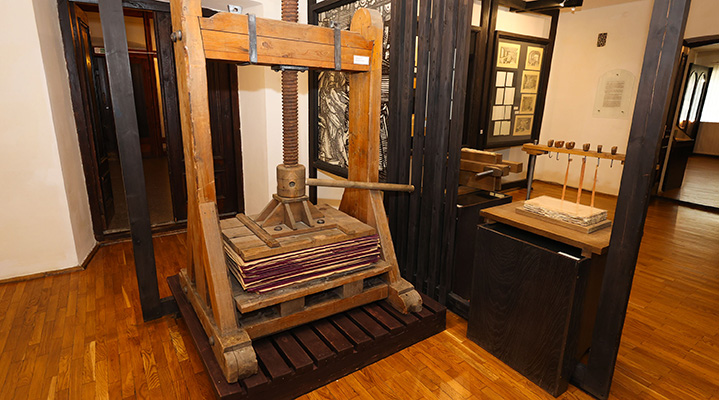 Skaryna was first schooled in his native Polotsk and studied Latin in the Bernardine monastery. He continued his studies in Krakow, and then in Padua. Later he founded a printing house in Prague. The famous Polotsk resident went down in history as a medical scholar, writer, philosopher, humanist, public figure and businessman. Polotsk’s central avenue and the square featuring a monument to the first printer were named after him.
Skaryna was first schooled in his native Polotsk and studied Latin in the Bernardine monastery. He continued his studies in Krakow, and then in Padua. Later he founded a printing house in Prague. The famous Polotsk resident went down in history as a medical scholar, writer, philosopher, humanist, public figure and businessman. Polotsk’s central avenue and the square featuring a monument to the first printer were named after him.
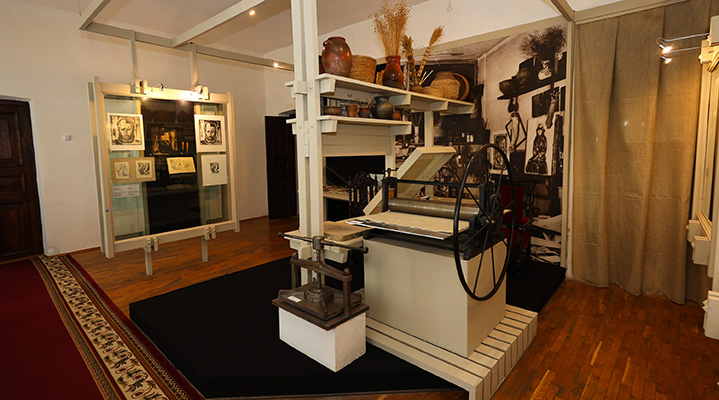 The Museum of Belarusian Book Printing opened its doors in 1990 to commemorate the 500th anniversary of Francysk Skaryna. The 15-hall museum holds some 2,500 artifacts which detail the story of the Belarusian printing industry from the very beginning to the present day. The exposition offers the entire chronology of Belarusian books associated with the names of Euphrosyne of Polotsk, Cyril of Turov, Francysk Skaryna and other prominent figures. Here one can see samples of paper and book making devices, and read rare pieces of handwritten manuscripts.
The Museum of Belarusian Book Printing opened its doors in 1990 to commemorate the 500th anniversary of Francysk Skaryna. The 15-hall museum holds some 2,500 artifacts which detail the story of the Belarusian printing industry from the very beginning to the present day. The exposition offers the entire chronology of Belarusian books associated with the names of Euphrosyne of Polotsk, Cyril of Turov, Francysk Skaryna and other prominent figures. Here one can see samples of paper and book making devices, and read rare pieces of handwritten manuscripts.
Where: 22 Nizhne-Pokrovskaya Street
Peter the Great’s house
There is a house in the historic center, in Nizhne-Pokrovskaya Street, that was built by decree of Peter I in 1692. It is known that the Emperor camped here during the Great Northern War to lead the army. The building is decorated with Baroque elements, including floral ornaments, while the front doors are beautified with stylized lion-shaped frescoes. Today, the building houses the museum “Walking along Nizhne-Pokrovskaya” dedicated to the fascinating past of the street.
Where: 33 Nizhne-Pokrovskaya Street
Children's Museum
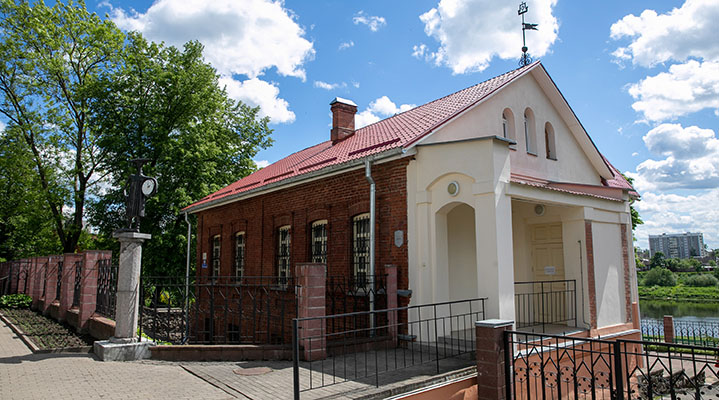 An unusual museum is housed in the building of the late 19th-early 20th centuries. Visitors to this interactive exposition are free to touch exhibits, bring mechanisms into action, and enjoy play areas. The goal of the museum is to help children understand how the laws of nature work, what the equilibrium and the process of time are. Anyone is welcome to contribute their collections to the museum. Thus, the museum has already had a chance to exhibit rare porcelain dolls, minerals and many other things.
An unusual museum is housed in the building of the late 19th-early 20th centuries. Visitors to this interactive exposition are free to touch exhibits, bring mechanisms into action, and enjoy play areas. The goal of the museum is to help children understand how the laws of nature work, what the equilibrium and the process of time are. Anyone is welcome to contribute their collections to the museum. Thus, the museum has already had a chance to exhibit rare porcelain dolls, minerals and many other things.
Where: 46 Nizhne-Pokrovskaya Street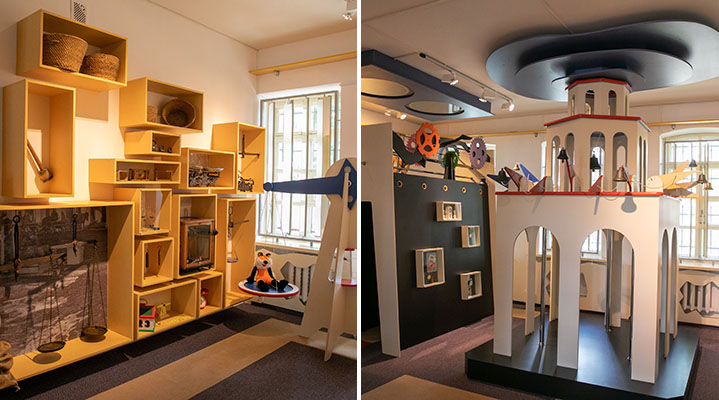
Museum of Traditional Hand Weaving of Poozerye Region
One of the most unusual museums of the town was opened in the building of the late 19th - early 20th centuries. Visitors are offered to see the whole process of the transformation of the famous Belarusian linen into woven products, which have accompanied the man since ancient times. Traditions and special rites, mysterious symbols and signs, legends and tales related to weaving represent a huge cultural layer of the Belarusian nation.
The museum offers guided tours, lectures, workshops, and the Batleika performance Herod the Great. The museum holds various festivals, including Koliada, Spring Calling, Volochobniki, and Bogach. The museum also invites young couples for an ancient wedding ceremony “How the two rivers merged” to attract happiness and prosperity to the young family.
Where: 1 Voikova Street
Nature and Ecology Museum
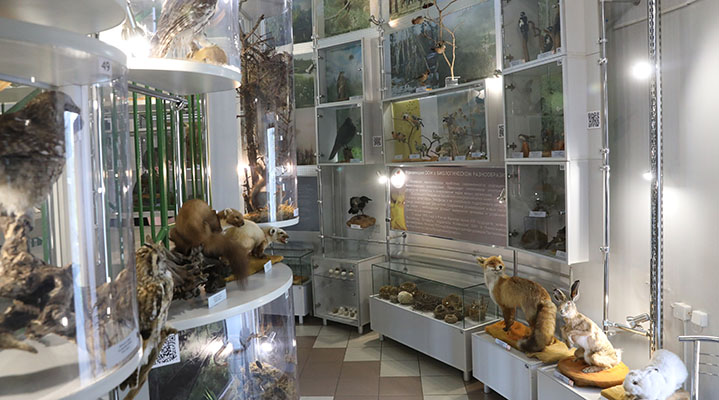 The museum is located in an old water tower that was built in 1953. As visitors ascend a spiral staircase, they get familiar with various periods of the development of the Earth and people’s environmental awareness. The first level is named “Belarus is Our Home”. It is dedicated to the biodiversity and unique nature of our country. The second level – “The Dowry of Civilization” – introduces visitors to environmental problems of the modern city. The third level – “Territories under Protection” – provides information about reserves and natural monuments as well as animal and plant species in the Red Book of Endangered Species. The fourth level is home to a lecture and exhibition hall and an observation point that offers a picturesque view of the town.
The museum is located in an old water tower that was built in 1953. As visitors ascend a spiral staircase, they get familiar with various periods of the development of the Earth and people’s environmental awareness. The first level is named “Belarus is Our Home”. It is dedicated to the biodiversity and unique nature of our country. The second level – “The Dowry of Civilization” – introduces visitors to environmental problems of the modern city. The third level – “Territories under Protection” – provides information about reserves and natural monuments as well as animal and plant species in the Red Book of Endangered Species. The fourth level is home to a lecture and exhibition hall and an observation point that offers a picturesque view of the town.
Where: 21 Francysk Skaryna Street
Museum of Medieval Chivalry
The museum takes its visitors on a journey to the Middle Ages. Its interior design features emblems of Belarusian nobility hanging on stone walls, wrought iron doors, and halls with authentic furniture. The museum holdings include rare collections of armor, household items, and weapons. Visitors are even allowed to touch or try on some exhibits. The director of the museum is a descendant of the ancient Rurik dynasty. He also acts as a guide. A monument to Prince Andrei of Polotsk is located near the museum.
Where: 3 Engelsa Street
Commemorative sign “Polotsk – the geographical center of Europe”
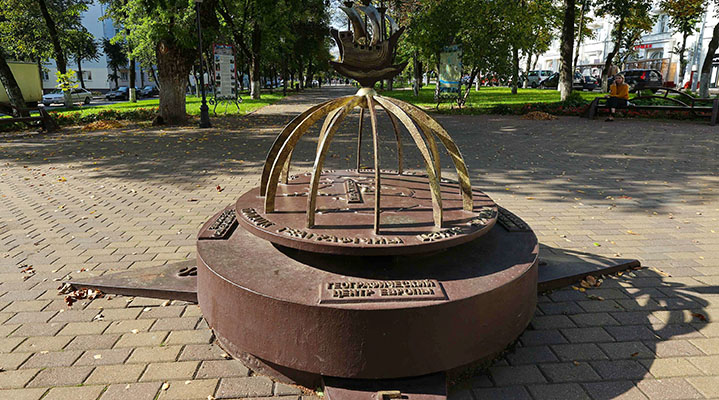 In 2000, Belarusian scientists Aleksei Solomonov and Valery Anoshko published the results of their research. With the help of a special software and their interpretation of the borders of Europe, the scientists concluded that the geographical center of Europe is located near Lake Sho (N 55° 30’ and Longitude: E 28° 48’ East), 48km away from Polotsk.
In 2000, Belarusian scientists Aleksei Solomonov and Valery Anoshko published the results of their research. With the help of a special software and their interpretation of the borders of Europe, the scientists concluded that the geographical center of Europe is located near Lake Sho (N 55° 30’ and Longitude: E 28° 48’ East), 48km away from Polotsk.
In the course of history, various locations claimed the right to this status depending on different calculation methods and definitions of the borders of Europe, and there is no unanimity about it to this very day. However, this does not prevent travelers from exploring the continent and visiting the most likely geographical centers.
The location pinpointed by the scientists is not in Polotsk. However, being the largest town in the vicinity and a legendary historic center, Polotsk became the place where travelers can get a certificate proving that they have been to the geographical center of Europe. The commemorative sign was unveiled in 2008. It shows a wind rose displaying the orientation of the cardinal directions and a map of Europe depicting the geographical center in Belarus. The intersecting arcs-meridians crowned with a three-masted ship symbolize the waterways that ran through that land in the past. The words on the sign are translated into five languages.
Where: Francysk Skaryna Avenue
Monument to unique Belarusian letter Ў
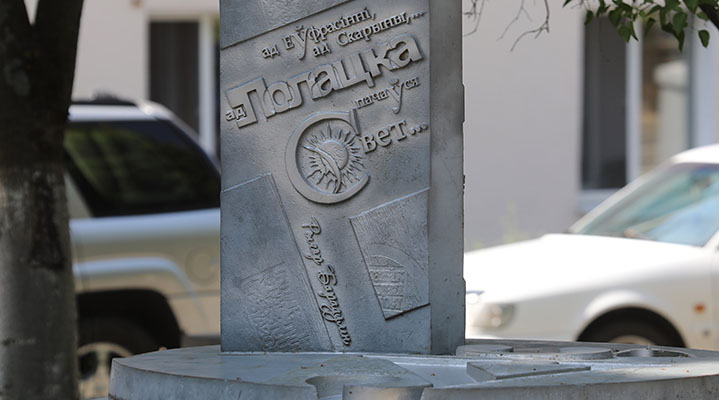 The unique monument to the 22nd letter of the Belarusian alphabet – Ў (non-syllabic U or short U) – was unveiled in Polotsk in 2003, during the tenth edition of the Belarusian Written Language Day celebrations. From ancient times, the melodic Belarusian speech was characterized by the short and light sound [w] (that the letter Ў stands for) pronounced after vowels. In texts that used the Latin script, this letter came in several variations: ú, u, ǔ, w̆, ŭ… However, in the 1870s – 1890s, the special letter ў was finally introduced to the Cyrillic script. It follows vowels and corresponds to several letters (and sounds) in other Slavic languages: у, в or л.
The unique monument to the 22nd letter of the Belarusian alphabet – Ў (non-syllabic U or short U) – was unveiled in Polotsk in 2003, during the tenth edition of the Belarusian Written Language Day celebrations. From ancient times, the melodic Belarusian speech was characterized by the short and light sound [w] (that the letter Ў stands for) pronounced after vowels. In texts that used the Latin script, this letter came in several variations: ú, u, ǔ, w̆, ŭ… However, in the 1870s – 1890s, the special letter ў was finally introduced to the Cyrillic script. It follows vowels and corresponds to several letters (and sounds) in other Slavic languages: у, в or л.
The idea to erect a monument to the letter was proposed by Professor Pavel Semchenko, a Belarusian calligrapher who studied various styles of scripts. The monument celebrates the letter Ў and the unique nature of Belarusian alphabet and culture in general. The alphabet and a quote from a poem by People’s Poet of Belarus Rygor Borodulin are engraved on the monument. It is located in a symbolic place – in the avenue named after the legendary first book printer, Francysk Skaryna.
Where: Francysk Skaryna Avenue
A monument to heroes of the Patriotic War of 1812
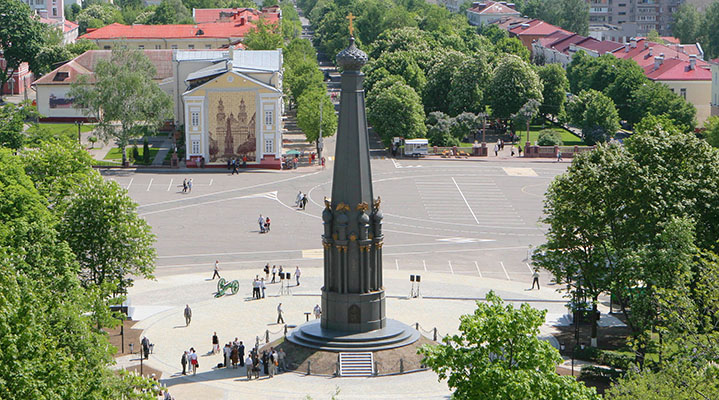 The first monument commemorating the Patriotic War of 1812 and the glorious victory in the battle for the town was unveiled in Polotsk in 1850. It became one of the 16 memorials erected upon orders of Emperor Nicholas I at the sites of the most significant battles. It is worth noting that the size of the monuments and their composition had to match the scale of the battles. The monuments were divided into three classes: there was only one monument of the first class, ten monuments of the second class, including one in Polotsk, and five monuments of the third class.
The first monument commemorating the Patriotic War of 1812 and the glorious victory in the battle for the town was unveiled in Polotsk in 1850. It became one of the 16 memorials erected upon orders of Emperor Nicholas I at the sites of the most significant battles. It is worth noting that the size of the monuments and their composition had to match the scale of the battles. The monuments were divided into three classes: there was only one monument of the first class, ten monuments of the second class, including one in Polotsk, and five monuments of the third class.
The Polotsk monument was made by a foundry in Lugansk and the manufacturing process took nearly two years. The monument was solemnly unveiled ahead of the anniversary of the legendary Battle of Borodino on 26 August 1850. Taking part in the ceremony were Crown Prince of the Russian Empire Alexander, province governors, an archbishop, representatives of the nobility, and other outstanding people of that age. The monument serves as a chapel and looks like the frustum of an octagonal pyramid with an onion-shaped dome and a golden Orthodox cross at the top. The middle part of the monument was decorated with eight pairs of columns with golden double-headed eagles.
Unfortunately, this monument has not survived because it was demolished in 1932 and melted. The monument to heroes of the Patriotic War of 1812 was reborn only recently. While working on the design, sculptors and architects used archive blueprints and photos as well as pictures of a similar monument, which still stands in Smolensk. The restored memorial was reopened in the central square of Polotsk on 21 May 2010 where the previous chapel once stood.
Monuments to outstanding people and events of Polotsk history
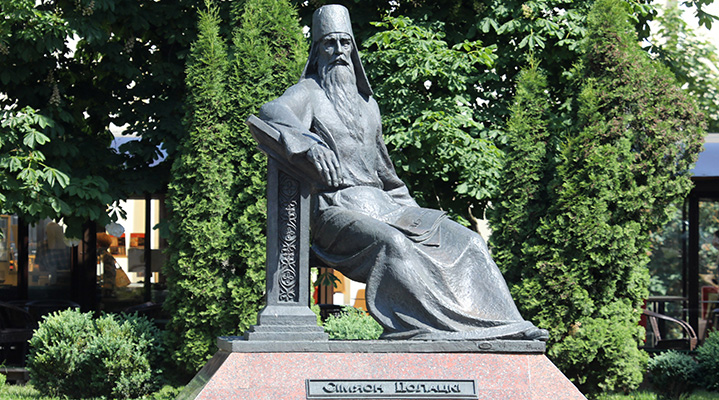 During a walking tour of Polotsk, visitors will often see interesting commemorative signs and monuments that tell the story of the eventful history of the town and its outstanding heroes. An image of St Euphrosyne of Polotsk is located in Svobody Square. The world’s first monument to Francysk Skaryna is located in the square named after this Belarusian printing pioneer. A monument to Symeon of Polotsk (Samuil Gavrilovich Petrovsky-Sitnyanovich) was erected in Skaryna Avenue.
During a walking tour of Polotsk, visitors will often see interesting commemorative signs and monuments that tell the story of the eventful history of the town and its outstanding heroes. An image of St Euphrosyne of Polotsk is located in Svobody Square. The world’s first monument to Francysk Skaryna is located in the square named after this Belarusian printing pioneer. A monument to Symeon of Polotsk (Samuil Gavrilovich Petrovsky-Sitnyanovich) was erected in Skaryna Avenue.
At the intersection of St Euphrosyne Street and Oktyabrskaya Street there is a bronze monument to the wise Prince Vseslav the Sorcerer. It is the first equestrian monument in Vitebsk Oblast created using only donations of citizens and philanthropists.
A monument to the Krivichs – an East Slavic tribe that founded Polotsk – is located at 34 Francysk Skaryna Avenue. It was made as a bronze Slavic boat (ladya), in which Princess Rogneda and her son Izyaslav stand surrounded by an armed retinue, who are ready to protect the rulers and the native land. Princess Rogneda and her son Izyaslav are the founding members of the Polotsk dynasty.
The monument to immortalize Polotsk as the birthplace of Belarusian statehood is located on the bank of the Western Dvina River near the walls of St Sophia Cathedral. The author Vladimir Pipin believes that the eight-tonne composition conveys many meanings. It resembles a cradle where the life of a person begins, a Slavic boat that floats on the river of eternity from the past into the future, and a crescent moon that has watched the world for millennia… Apart from that, the monument represents a gallery of shields: on one side there are images of famous historical figures starting with Prince Rogvolod and his daughter Rogneda and ending with Vseslav the Sorcerer and Euphrosyne of Polotsk while the other side is used to depict Belarusian statehood evolution milestones.
Polotsk bridges
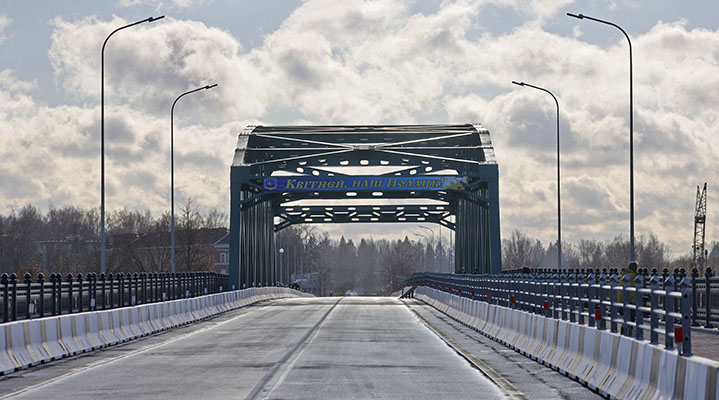 Bridges have always been a necessity in the town of several rivers. There are five bridges at present: two cross the Dvina River, two cross the Polota River, and one bridge crosses the Belchanka River. The bridge over the Polota River has earned its place in history as the Red Bridge. It was on this bridge that French troops and Russian armies clashed fiercely in October 1812, leaving the bridge planking fully splashed with the blood of the soldiers…A new reinforced-concrete bridge was built instead of the wooden one in 1975. The new bridge retained decorative elements of the previous one. A commemorative sign with text in honor of the fallen warriors stands in front of the bridge.
Bridges have always been a necessity in the town of several rivers. There are five bridges at present: two cross the Dvina River, two cross the Polota River, and one bridge crosses the Belchanka River. The bridge over the Polota River has earned its place in history as the Red Bridge. It was on this bridge that French troops and Russian armies clashed fiercely in October 1812, leaving the bridge planking fully splashed with the blood of the soldiers…A new reinforced-concrete bridge was built instead of the wooden one in 1975. The new bridge retained decorative elements of the previous one. A commemorative sign with text in honor of the fallen warriors stands in front of the bridge.
A suspension bridge for pedestrians crosses the Polota River near St Euphrosyne Convent. The city dwellers gave it a romantic name: the Bridge of Kisses… Since recently it leads to a symbolic place where another tragedy in the history of Polotsk happened.
The Urochishche Peski memorial
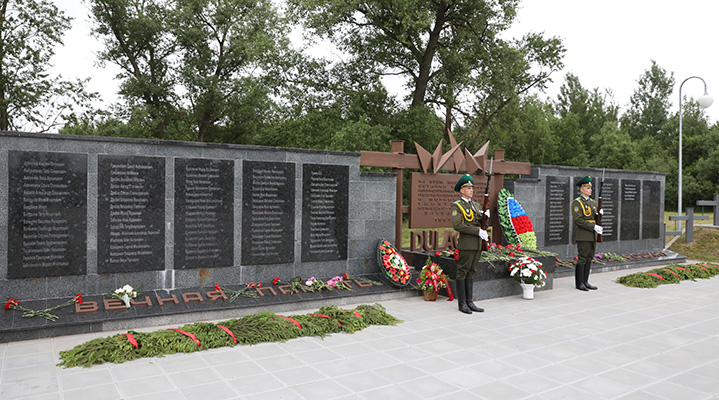 Set up at a site of mass graves that emerged in the bloodiest years in the country’s history, the Urochishche Peski memorial complex was opened in Polotsk on 22 June 2020, the day of nationwide remembrance of victims of the Great Patriotic War of 1941-1945. It was here – not far from St Euphrosyne Convent – that the Nazi set up the transit camp Dulag-125 for Soviet prisoners of war. People shot and hanged in the civilian camp Gromy were brought here. Inmates of the municipal prison and the gestapo were buried here as well. Tens of thousands of Nazi victims were buried in huge mass grave.
Set up at a site of mass graves that emerged in the bloodiest years in the country’s history, the Urochishche Peski memorial complex was opened in Polotsk on 22 June 2020, the day of nationwide remembrance of victims of the Great Patriotic War of 1941-1945. It was here – not far from St Euphrosyne Convent – that the Nazi set up the transit camp Dulag-125 for Soviet prisoners of war. People shot and hanged in the civilian camp Gromy were brought here. Inmates of the municipal prison and the gestapo were buried here as well. Tens of thousands of Nazi victims were buried in huge mass grave.
The remains of the dead were not disturbed in the course of creating the memorial complex. A chapel was built at the site as well as a wall of remembrance bearing last names of the dead that were verified and bearing symbols of several religions - Orthodoxy, Catholicism, Judaism, and Islam. The entrance into the memorial complex has been made in the form of a cross with a wreath of thorns. Anyone can light a candle in the chapel.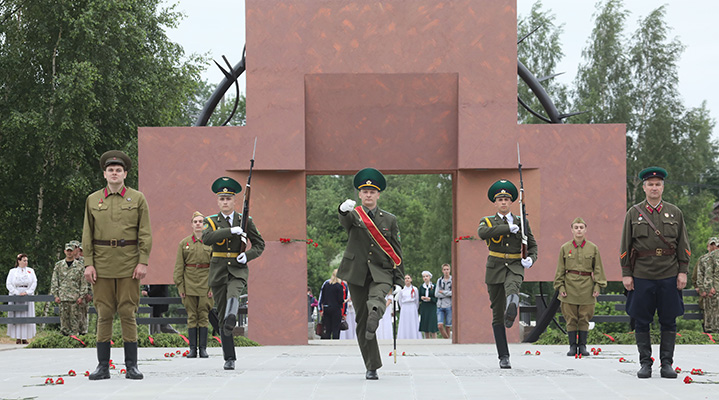
The Mound of Immortality
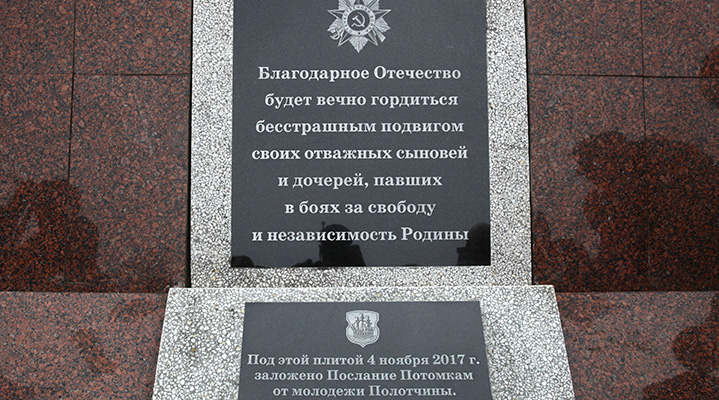 The Great Patriotic War of 1941-1945 was a tragedy for many nations. Every city, every town, every district remembers those tragic years. Battles on the banks of the Western Dvina River took lives of about 200,000 people. As a token of remembrance the Mound of Immortality was created in Polotsk in summer 1966. The hill is ten meters high. It was poured using ashes of the burned-down villages, soil from mass graves in various parts of Vitebsk Oblast, from various battlefields, from the Brest Fortress, and from the Olsany cemetery of the Soviet warriors in Prague. There is a platform at the top of the mound and a torch that gets lit in memory of the fallen on festive days and days of mourning.
The Great Patriotic War of 1941-1945 was a tragedy for many nations. Every city, every town, every district remembers those tragic years. Battles on the banks of the Western Dvina River took lives of about 200,000 people. As a token of remembrance the Mound of Immortality was created in Polotsk in summer 1966. The hill is ten meters high. It was poured using ashes of the burned-down villages, soil from mass graves in various parts of Vitebsk Oblast, from various battlefields, from the Brest Fortress, and from the Olsany cemetery of the Soviet warriors in Prague. There is a platform at the top of the mound and a torch that gets lit in memory of the fallen on festive days and days of mourning.
A park dedicated to the 50th anniversary of the Soviet government was planted at the foot of the monument. There is also a combat glory museum at the site that contains an exposition of the history of the monument’s construction.


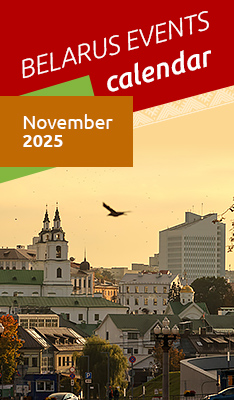




 print version
print version make home page
make home page add to bookmarks
add to bookmarks
